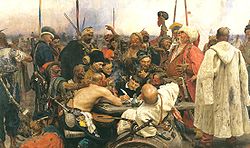- Yesaul
-
- For the town in Armenia, see Ovuni.
Part of a series on Cossacks 
Cossack hosts Azov · Black Sea · Buh · Caucasus · Danube · Don · Volga · Ural · Terek · Kuban · Orenburg · Astrakhan · Siberian · Baikal · Amur · Semirechye · Ussuri · Zaporozhia Other groups Danube (Sich) · Tatar Cossacks · Nekrasov · Turkey · Jewish Cossacks History Registered Cossacks · Kosiński Uprising · Nalyvaiko Uprising · Khmelnytsky Uprising · Hadiach Treaty · Hetmanate · Colonisation of Siberia · Bulavin Rebellion · Pugachev's Rebellion · 1st Cavalry Army · Decossackization · Betrayal · XV SS Cossack Cavalry Corps · 1st Cossack Division Famous Cossacks Bohdan Khmelnytsky · Petro Sahaidachny · Ivan Vyhovsky · Petro Doroshenko · Ivan Mazepa · Ivan Sirko · Yemelyan Pugachev · Stenka Razin · Yermak Timofeyevich Cossack terms Ataman · Hetman · Kontusz · Papakhi · Plastun · Szabla · Shashka · Stanitsa · Yesaul Yesaul, or Osaul ( Russian: есау́л [jɪsɐˈul]), Ukrainian: осавул (from Turkic yasaul - chief),[1] a post and a rank in the Ukrainian and Russian Cossack units.
The first records of the rank imply that it was introduced by Stefan Batory, King of Poland in 1576.
Contents
Cossacks in Russia
There were different yesaul posts and ranks in Cossack Hosts in Imperial Russia:
- Генеральный есаул (Generalny yesaul) - General Yesaul
- Походный есаул (Pokhodny yesaul) - Campaign Yesaul
- Войсковой есаул (Voiskovoy yesaul) - Army Yesaul
- Полковой есаул (Polkovoy yesaul) - Regimental Yesaul
- Артиллерийский есаул (Artilleriysky yesaul) - Artillery Yesaul
- Сотенный есаул (Sotenny yesaul) - Company Yesaul (commander of a sotnia)
- Станичный есаул (Stanichny yesaul) - Yesaul of a stanitsa
Cossack Hetmanate
In Ukraine of 17th and 18th centuries osaul was a military and administrative official performing the duties of aide-de-camp.[2] The head of state, hetman, would appoint up to two osauls known as a General Osaul. There also was a Regimental Osaul as well as Company Osaul, with each regular cossack regiment and company except artillery having two of each. Beside them there were osauls under special assignments one of them serving for General Obozny (quartermaster) who performed duties of a chief executive and was the second in importance after Hetman.
General Osaul
A senior officer of a Hetmanate cossack army who was a member of the general officer staff.
- Duties
- supervising army's condition
- leading large detachments (wartime)
- managing muster rolls
- directing the army engineers
- commanding mercenary troops
- sometimes serving as an acting hetman
Other duties consisted of being a hetman's envoy, supervised matters of internal security, conducted annual regimental musters and inspections. Among the notorious osauls were Petro Doroshenko, Demian Mnohohrishny, Ivan Mazepa, and Ivan Skoropadsky.
In 1798–1800 after the liquidation of Zaporizhian Host, the rank of osaul was equated with the ranks of rittmeister in cavalry and captain in infantry.
References
- ^ Russian humanitarian encyclopedic dictionary (Russian)
- ^ Encyclopedia of Ukraine (English)
External links
Categories:- Military organization of Cossacks
- Military ranks of Russia
- Military ranks of Ukraine
- Ukrainian history stubs
- Ukraine stubs
- Russian military stubs
- Military rank stubs
- European military stubs
Wikimedia Foundation. 2010.
